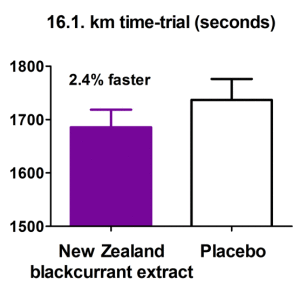Is New Zealand blackcurrant a new ergogenic aid in sport?
Matthew Cook is the world's first PhD in New Zealand Blackcurrant for sports and exercise sciences. Here, he outlines the CurraNZ research that revealed its effect on fat oxidation in athletes.
Atlas of Science article - click here
THE daily consumption of fruit and vegetables in appropriate amounts will provide health benefits. Fruit and vegetables are multi-ingredient foods with the anthocyanin content potentially linked to the health benefits due to its known anti-inflammatory and anti-oxidant activity.
Anthocyanins are responsible for the colours in fruits and vegetables. New Zealand blackcurrant has a high anthocyanin content, possibly due to the environmental and growing conditions.
Blackcurrant intake is known to increase peripheral blood flow during physical activity of low intensity. This is important for an exercising human, as the blood delivers the nutrients and oxygen and removes waste products from working muscles.
In mice, it was shown that some of the anthocyanins that are present in blackcurrant resulted in less accumulation of body fat. It is therefore possible that humans use more fat as well and if that happens during exercise it could be beneficial for endurance performance.
However, researchers never looked whether New Zealand blackcurrant would be helpful for endurance performance in athletes.
In our study, we had 14 male athletes from cycling and triathlon clubs, who cycled typically about 8 to 10 hours a week.
The study used a double-blind randomized cross-over design which means that the athletes and the researcher did not know whether they were taking New Zealand blackcurrant or placebo.
It was also not known to the athletes and researcher what the order of testing was. This is all done to prevent bias in the study. The New Zealand blackcurrant extract (CurraNZ) or placebo was taken for 7 days and athletes were tested whether they used more fat and whether they were faster on a time-trial of 16.1 km.
We observed that fat oxidation was substantially higher with New Zealand blackcurrant extract (Fig. 1). Our athletes were also able to cycle on average 2.4% faster during the time-trial (Fig. 2) and such improvement is meaningful in the real world of sport.
As far as we know, this study provided the first beneficial observations of New Zealand blackcurrant, and the first observations for a berry, on endurance performance.
More research on the effectiveness of New Zealand blackcurrant needs to be done but our promising results may have implications for nutritional strategies used by athletes to enhance performance.
Matthew Cook, Stephen Myers, Sam Blacker, Mark Willems
Department of Sport and Exercise Sciences
University of Chichester
United Kingdom
